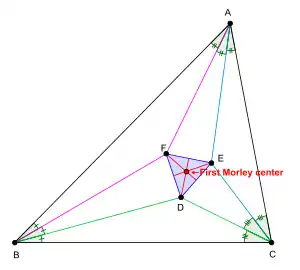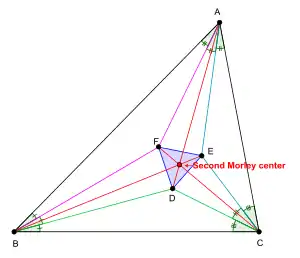Morley centers
In geometry the Morley centers are two special points associated with a plane triangle. Both of them are triangle centers. One of them called first Morley center[1] (or simply, the Morley center[2] ) is designated as X(356) in Clark Kimberling's Encyclopedia of Triangle Centers, while the other point called second Morley center[1] (or the 1st Morley–Taylor–Marr Center[2]) is designated as X(357). The two points are also related to Morley's trisector theorem which was discovered by Frank Morley in around 1899.


Definitions
Let DEF be the triangle formed by the intersections of the adjacent angle trisectors of triangle ABC. Triangle DEF is called the Morley triangle of triangle ABC. Morley's trisector theorem states that the Morley triangle of any triangle is always an equilateral triangle.
Trilinear coordinates
First Morley center
The trilinear coordinates of the first Morley center of triangle ABC are [1]
- cos ( A/3 ) + 2 cos ( B/3 ) cos ( C/3 ) : cos ( B/3 ) + 2 cos ( C/3 ) cos ( A/3 ) : cos ( C/3 ) + 2 cos ( A/3 ) cos ( B/3 ).
Second Morley center
The trilinear coordinates of the second Morley center are
- sec ( A/3 ) : sec ( B/3 ) : sec ( C/3 ).
References
- Kimberling, Clark. "1st and 2nd Morley centers". Retrieved 16 June 2012.
- Kimberling, Clark. "X(356) = Morley center". Encyclopedia of Triangle Centers. Retrieved 16 June 2012.
- Weisstein, Eric W. "Morley Centers". Mathworld – A Wolfram Web Resource. Retrieved 16 June 2012.
